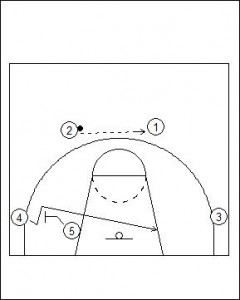Introduction to Flex Offense
From the moment of its introduction the Flex offense has been regarded as the most popular form of offense used in Basketball. It emerged in the 1970’s and is now widely used around the world. At its simplest the Flex offense is nothing more than just a patterned movement of players performing cuts and screens constantly. Additionally, few glimpses of “Pick-the-Picker” action can be seen in Flex offense. It requires utility and versatile players who can play any position inside the key or on the perimeter.
The Flex offense was introduced initially to nullify the strategy of man-to-man marking. Today, coaches still execute this offense because it is very easy to remember the cuts and screens. The best thing about this strategy is that no player is the main focus; instead everyone is expected to contribute equally. It requires a constant movement of players and passing of the ball at a high tempo. A common criticism of Flex offense is that the pattern is highly predictable.
Within this offense, no specific position is needed to be defined as it involves all the five players in cuts and screens. Depending on the desired strategy, for example a Centre can start on the perimeter.
The Flex cut starts with a player who is standing in the corner and then the player just cuts off the screener, cuts directly off screen to the basket (Refer to diagrams below). All the players are made to practice this movement, so that during match they can utilize this pivotal part of the offense. This cutting tactic is performed from both the sides of the court.
The Flex offense has undergone several changes in the modern times. In today’s basketball environment more emphasis is given on closer shots rather than the conventional open perimeter jump shots. Some versions of flex offense include all the on-field players in cutting and screening while some recent versions only make use of four players in both cutting and screening. Some of the newer developments within the Flex offense are somewhat similar to the technique of the Shuffle Offense.
It’s important to note that the Flex offense can be run continuously in its basic pattern. This means the offense is also described as a continuity offense. As a coach, there are several advantages of this technique. As this offense is perpetuation of repeated patterns, so is it very easy to teach. As a coach take care to incorporate some counter plays to reduce the offences overall predictability. Also make sure as a coach you instruct your players in the different ‘reads’ that are available when utilising the screens, cutting and scoring options when holding the ball to be aware of.
So how do you coach to beat an opponent that is using a Flex offense? The first suggestion is to take the time to break down the patterns with your team and staff. Understanding the movements is of great benefit to all players on the court. As it is highly predictable its main pattern involving screening (Flex cut and down screens) can be encountered quite comfortably by switching the screens.

Flex: Standard Guard to Guard Pass
Guard to guard pass is made across the middle lane/split line (One to two).
Low post player Five (5) sets a screen for player in the long corner (Four 4).
Four (4) cuts over the screen across the keyway to opposite low post (weak side).
Scoring Options,
- Dribble penetration from perimeter
- Pass to cutter off of screen (Four)
- Pass to screener (Five)

After passing Two (2) flash cuts to broken circle and if the player does not receive the ball then sets down screen for Five (5).
Five cuts over screen to split-line or flash cuts to ball for shot.
If Five (5) does not receive the pass then moves to replaces the position of the screener (2).
Two (2) after setting the screen drop steps to the basket looking for pass. If the pass is not received then moves to the weak-side long corner.
The play then continues on the opposite side of the floor.

Flex: Standard Guard to Forward Pass
On a guard to forward pass (Two to Four), the strong-side players (Two and Five) screen away for weak-side players (One and Three).
Two (2) screens for One (1). One cuts over screen to broken circle. It is important that Two (2) opens up to the ball on the perimeter so the possibility of a pressure release pass or skip pass for a three point shot can be made.
Five (5) screens for Three (3). Three cuts over screen to basket.
Five (5) after looking for possible receiver spots locates to the weak side long corner.
If no scoring pass is made players fill positions and run Flex: Standard Guard to Guard Pass.


